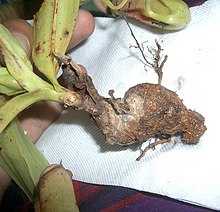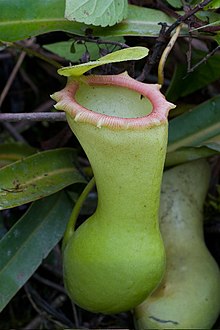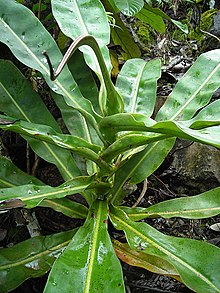Pitcher plants
| Pitcher plants | ||||||||||||
|---|---|---|---|---|---|---|---|---|---|---|---|---|

Nepenthes maxima |
||||||||||||
| Systematics | ||||||||||||
|
||||||||||||
| Scientific name of the family | ||||||||||||
| Nepenthaceae | ||||||||||||
| Dumb. | ||||||||||||
| Scientific name of the genus | ||||||||||||
| Nepenthes | ||||||||||||
| L. |
Pitcher plants ( Nepenthes ) are the only genus in the pitcher plant family (Nepenthaceae). Around 100 species are now known, but new species are still regularly discovered and described. All species are tropical carnivorous plants .
description
Pitcher plants are evergreen, perennial plants , depending on the type, subshrubs or lianas . Some species also form rosettes and are rather compact in growth. As far as is known, all species have a constant number of chromosomes (2n = 80), which is why all species can be crossed fertile with each other.
root

Pitcher plants usually have a well-developed, richly branched root system , but are shallow-rooted. Many types of roots have a fragile structure and are susceptible to failure. But there are also species whose roots are strongly thickened and help the plant to survive dry periods , e.g. B. Nepenthes kampotiana or Nepenthes mirabilis (see fig.).
leaves
The leaves stand alternately from the stem axis. The leathery, lanceolate to elongated or egg-shaped leaf blade only represents a transformed leaf base in the strict sense . This is divided by a strong central rib that merges into a thick tendril that ends at the base of the pot. Only the upright pitchers covered by a lid are the actual leaf blades.
Pitchers

The Nepenthes pitchers are passive pitfalls, the lid is fixed. The plants anchor themselves in the trees with the help of the pitcher handle. The digestive fluid in the jug is very acidic (pH 3) and enriched with many enzymes. The digestion of soft-skinned prey can be completed within two days. Most species form differently shaped bottom pitchers and high pitchers on the long shoots, this is an adaptation to the creeping or flying prey. In addition, the pitchers on young plants look completely different than pitchers on fully grown plants. In their natural habitat, some Nepenthes species develop pitchers up to 50 cm in size.
Flowers and seeds
Pitcher plants are dioecious separately sexed ( diocesan ). They form panicles or grape-shaped inflorescences composed of cymen . The shafts of the inflorescences are between 15 and 100 cm long, so the flowers are well above the plants.
The flowers usually have four, rarely three petals. The unisexual flowers have no rudiments of the opposite sex. Male flowers have 4 to 24 stamens, female flowers usually have four, rarely three, carpels.
The flowers are pollinated by beetles and flies . The three-way seed pods contain up to 500 fine seeds that are distributed by the wind.
Distribution and habitat
The distribution center of the genus is in Indonesia, Malaysia and the Philippines, the islands of Borneo and Sumatra are particularly rich in (often endemic ) species . Disjoint occurrences are found west to Madagascar (2 species) and the Seychelles (1 species), south to Australia (2 species), New Caledonia (1 species) and in the north to India (1 species), Sri Lanka (1 species) and China (1 kind).
The following table shows the distribution of the genus taking into account the number of species and endemics.
| area | Number of species | Number of endemics |
|---|---|---|
| Australia | 2 | 1 |
| Seychelles | 1 | 1 |
| Sri Lanka | 1 | 1 |
| India | 1 | 1 |
| New Caledonia | 1 | 1 |
| Java | 2 | 1 |
| Madagascar | 2 | 2 |
| Moluccas | 3 | 0 |
| Indochina | 3 | 1 |
| Celebes | 9 | 4th |
| Malaya | 11 | 4th |
| Philippines | 10 | 8th |
| New Guinea | 10 | 8th |
| Sumatra | 29 | 16 |
| Borneo | 34 | 25th |
Many species (e.g. Nepenthes rafflesiana ) live in the hot, humid lowland areas, but most are inhabitants of the tropical mountainous region with warm days all year round and cool to cold, humid nights. A few species (e.g. Nepenthes clipeata ) live in mountainous regions with cool days and nights close to freezing. Most pitcher plants prefer moist, bright, not full sun locations, but in some regions there are also those that do not mind full sun (e.g. Nepenthes neoguineensis ).
Botanical history
The first tangible mention and description of Nepenthes comes from the year 1658, when the French governor Étienne de Flacourt traveled to Madagascar and came across Nepenthes madagascariensis . He admired the unusual appearance of the plant, but saw the pitchers as flowers, not as insect traps.
A second description of a Nepenthes species was made in 1680 by the German traveler and adventure researcher Jacob Breyne . He brought a specimen of Nepenthes mirabilis with him, but named the plant "Bandura cingalensis". He, too, saw the pitchers as blossoms, not as insect traps.
The natural scientist Carl von Linné introduced the generic name Nepenthes in his work Species Plantarum in 1753 . When choosing the name, he resorted to Homer's report on the drug Népênthos (Greek: “Sorrowful”) (Odyssey, Canto 4, 221), which Telemachus, Odysseus 'son, was offered by Helena, Zeus' daughter, and should make you forget all sorrow.
Pitcher plants grew in popularity in the 19th century. In particular, the nursery Veitch and Sons under its then owner Peter Christian Massyn Veitch imported all conceivable species and hybrids of Nepenthes from the natural sites by means of plant hunters and continued to breed them. From 1960 the pitcher plants experienced a new "boom" through the literature of the Japanese botanist Shigeo Kurata .
Today about 104 species and several hundred hybrids are known, some of which are available in flower shops, garden centers, and even hardware stores.
Endangerment status
Many species are directly threatened with extinction through the collection and sale as well as the deforestation of the rainforests, so over 50 species are listed on the IUCN's Red List as critically endangered, threatened or endangered. All Nepenthes species are now protected by the Washington Convention on the Protection of Species (CITES), Nepenthes rajah and Nepenthes khasiana in Appendix 1, all other species in Appendix 2.
Paleobotany and Evolution
Fossilized pollen finds from the European Tertiary in the 1930s were classified in 1985 as originating from three extinct species ( Nepenthes echinosporus , Nepenthes echinatus , Nepenthes major ). It is possible that the Nepenthes originally came from Europe and, with the successive climatic changes, migrated from there to the current area of distribution, where the tropical climate guaranteed them appropriate conditions.
use
Use in ethnobotany
Pitcher plants have been used in many ways in their home countries. The jug liquid is used as a drink, Borneo reports that the sprout was used as a building material and the jug was used as a rice cooker.
In folk medicine, the juice is used as a remedy for coughs and bladder problems, as well as for eye diseases and skin inflammation, decoctions of roots and stems should be used for B. be helpful in dysentery or malaria .
Use as an ornamental plant
Pitcher plants are particularly popular ornamental plants in the USA, but also in Central Europe . With the exception of a few simpler species (e.g. Nepenthes alata , Nepenthes ventricosa , Nepenthes rafflesiana or Nepenthes truncata ), the cultivation of some species is not that uncomplicated and requires at least a terrarium, or better still a temperature-controlled greenhouse with high humidity. Highland species in particular are considered difficult to cultivate because they need a lot of cooling at night.
Many of the commercially available Nepenthes are hybrids, which are usually more vigorous and robust than the pure species and can also thrive in spatial conditions. The hybrids 'Ventrata' ( Nepenthes alata × Nepenthes ventricosa ), 'Mixta' ( Nepenthes northiana × Nepenthes maxima ) and 'Coccinea' ( Nepenthes alata × Nepenthes ampullaria ) are particularly common .
photos
Nepenthes at the natural habitat in New Guinea
Illustration of the greenhouses by J. Veitch around 1870
Systematics
The system is based on Jebb & Cheek, 1997 and has been supplemented by new descriptions, including from Jan Schlauer's CP database.
- Nepenthes adnata Tamin & M. Hotta ex Schlauer : It occurs in Sumatra.
- Nepenthes alata Blanco : It occurs in the Philippines.
- Nepenthes albomarginata T. Lobb ex Lindl. : It occurs in Malaysia, Indonesia and Brunei.
- Nepenthes ampullaria Jack : It occurs in Thailand, Indonesia, Brunei, Malaysia, Singapore and New Guinea.
- Nepenthes argentii Jebb & Cheek : It occurs in the Philippines.
- Nepenthes aristolochioides Jebb & Cheek : It occurs in Sumatra.
- Nepenthes attenboroughii A.S.Rob., S.McPherson & VBHeinrich : It occurs on Palawan .
- Nepenthes bellii Kondô : It occurs in Mindanao .
- Nepenthes benstonei C. Clarke : It occurs in Thailand and Malaysia.
- Nepenthes bicalcarata Hook. f. : It occurs in Malaysia, Indonesia and Brunei.
- Nepenthes bongso Korth. : It occurs in Sumatra.
- Nepenthes boschiana Korth. : It occurs in Kalimantan .
- Nepenthes burbidgeae Hook. f. ex Burb. : It occurs in Sabah .
- Nepenthes burkei hoard. Veitch ex mast. : It occurs in the Philippines.
- Nepenthes campanulata Sh. Kurata : It occurs in Indonesia and Malaysia.
- Nepenthes chaniana C. Clarke et al. : It occurs in Sabah and Sarawak .
- Nepenthes clipeata Danser : It occurs in Kalimantan .
- Nepenthes danseri Jebb & Cheek : It occurs in Indonesia.
- Nepenthes deaniana Macfarl. : It occurs in Palawan .
- Nepenthes densiflora Danser : It occurs in Sumatra.
- Nepenthes diatas Jebb & Cheek : It occurs in Sumatra.
- Nepenthes distillatoria L .: It occurs in Sri Lanka.
- Nepenthes dubia Danser : It occurs in Sumatra.
- Nepenthes edwardsiana H. Low ex Hook. f. : It occurs in Sabah .
- Nepenthes ephippiata Danser : It occurs in Kalimantan .
- Nepenthes eustachya Miq. : It occurs in Sumatra.
- Nepenthes eymae Sh. Kurata : It occurs on Celebes .
- Nepenthes faizaliana J. H. Adam & Wilcock : It occurs in Sarawak.
- Nepenthes fallax Beck
- Nepenthes fusca Danser : It occurs in Malaysia, Indonesia and Brunei.
- Nepenthes glabrata J. R. Turnbull & AT Middleton : It occurs on Celebes .
- Nepenthes glandulifera Chi C. Lee : It occurs in Sarawak.
- Nepenthes gracilis Korth. : It occurs in Thailand, Indonesia, Malaysia, Brunei and Singapore.
- Nepenthes gracillima Ridl. : It occurs in Malaysia.
- Nepenthes gymnamphora Nees : It occurs in Java.
- Nepenthes hamata J. R. Turnbull & AT Middleton : It occurs on Celebes .
- Nepenthes hirsuta Hook. f. : It occurs in Malaysia, Indonesia and Brunei.
- Nepenthes hurrelliana Cheek & AL Lamb : It occurs in Sabah and Brunei.
- Nepenthes inermis Danser : It occurs in Sumatra.
- Nepenthes insignis Danser : It occurs in Indonesia.
- Nepenthes izumiae Troy Davis et al. : It occurs in Sumatra.
- Nepenthes jacquelineae C. Clarke et al. : It occurs in Sumatra.
- Nepenthes jamban, Chi C. Lee, et al. : It occurs in Sumatra.
- Nepenthes khasiana Hook. f. : It occurs in India.
- Nepenthes klossii Ridl. : It occurs in Indonesia.
- Nepenthes lamii Jebb & Cheek : It occurs in Indonesia.
- Nepenthes lavicola Wistuba & Rischer : It occurs in Sumatra.
- Nepenthes leonardoi S.McPherson, Bourke, Cervancia, Jaunzems & ASRob.
- Nepenthes lingulata Chi C. Lee et al. : It occurs in Sumatra.
- Nepenthes longifolia Mink & Wistuba : It occurs in Sumatra.
- Nepenthes lowii Hook. f. : It occurs in Indonesia, Malaysia and Brunei.
- Nepenthes macfarlanei Hemsl. : It occurs in Malaysia.
- Nepenthes macrophylla (Marabini) Jebb & Cheek : It occurs in Sabah.
- Nepenthes macrovulgaris J.R. Turnbull & AT Middleton : It occurs in Sabah.
- Nepenthes madagascariensis Poir. : It occurs in Madagascar.
- Nepenthes mantalingajanensis Nerz & Wistuba : It occurs on Palawan .
- Nepenthes mapuluensis J. H. Adam & Wilcock : It occurs in Kalimantan.
- Nepenthes masoalensis Schmid-Hollinger : It occurs in Madagascar.
- Nepenthes maxima Reinw. ex Nees : It occurs in Indonesia and New Guinea.
- Nepenthes merrilliana Macfarl. : It occurs in Mindanao .
- Nepenthes mikei B. R. Salmon & Maulder : It occurs in Sumatra.
- Nepenthes mindanaoensis Sh. Kurata : It occurs in Mindanao .
- Nepenthes mira Jebb & Cheek : It occurs in Palawan .
- Nepenthes mirabilis (Lour.) Druce : It occurs in Thailand, Cambodia, Laos, Vietnam, China, Indonesia, Malaysia, Brunei, Singapore, the Philippines, New Guinea, Queensland, Palau and Micronesia .
- Nepenthes mollis Danser : It occurs in Kalimantan.
- Nepenthes muluensis M. Hotta : It occurs in Sarawak.
- Nepenthes neoguineensis Macfarl. : It occurs in New Guinea and Indonesia.
- Nepenthes northiana Hook. f. : It occurs in Sarawak.
- Nepenthes ovata Mink & Wistuba : It occurs in Sumatra.
- Nepenthes paniculata Danser : It occurs in Indonesia.
- Nepenthes papuana Danser : It occurs in Indonesia.
- Nepenthes pervillei flower : It occurs in the Seychelles.
- Nepenthes petiolata Danser : It occurs in Mindanao .
- Nepenthes philippinensis Macfarl. : It occurs in Palawan .
- Nepenthes pilosa Danser : It occurs in Indonesia and Malaysia.
- Nepenthes platychila Chi C. Lee : It occurs in Sarawak.
- Nepenthes pyriformis Sh. Kurata : It occurs in Sumatra.
- Nepenthes rafflesiana Jack ex Hook. f. : It occurs in Malaysia, Indonesia, Brunei and Singapore.
- Nepenthes rajah hook. f. : It occurs in Sabah.
- Nepenthes reinwardtiana Miq. : It occurs in Malaysia, Indonesia and Brunei.
- Nepenthes rhombicaulis Sh. Kurata : It occurs in Sumatra.
- Nepenthes rigidifolia Akhriadi et al. : It occurs in Sumatra.
- Nepenthes robcantleyi Cheek
- Nepenthes rowanae F. M. Bailey : It occurs in Queensland.
- Nepenthes sanguinea Lindl. : It occurs in Thailand and Malaysia.
- Nepenthes saranganiensis Sh. Kurata : It occurs in Mindanao .
- Nepenthes sibuyanensis mink : It occurs in the Philippines.
- Nepenthes singalana Becc. : It occurs in Sumatra.
- Nepenthes smilesii Hemsl. (Syn .: Nepenthes anamensis Macfarl. ): It occurs in Thailand, Cambodia, Laos and Vietnam.
- Nepenthes spathulata Danser : It occurs in Sumatra.
- Nepenthes spectabilis Danser : It occurs in Sumatra.
- Nepenthes stenophylla mast. : It occurs in Malaysia, Indonesia and Brunei.
- Nepenthes sumatrana (Miq.) Beck : It occurs in Sumatra.
- Nepenthes talangensis Mink & Wistuba : It occurs in Sumatra.
- Nepenthes tenax C.Clarke & R.Kruger : It occurs in Queensland.
- Nepenthes tentaculata Hook. f. : It occurs in Malaysia, Indonesia and Brunei.
- Nepenthes tenuis Mink & Wistuba : It occurs in Sumatra.
- Nepenthes thorelii Lecomte : It occurs in Thailand, Cambodia and Vietnam.
- Nepenthes tobaica Danser : It occurs in Sumatra.
- Nepenthes tomoriana Danser : It occurs on Celebes .
- Nepenthes treubiana Warb. : It occurs in Indonesia.
- Nepenthes truncata Macfarl. : It occurs in Mindanao .
- Nepenthes veitchii Hook. f. : It occurs in Malaysia, Indonesia and Brunei.
- Nepenthes ventricosa Blanco : It occurs on Luzon .
- Nepenthes vieillardii Hook. f. : It occurs in New Caledonia .
- Nepenthes villosa Hook. f. : It occurs in Sabah.
- Nepenthes vogelii Schuit. & de Vogel : It occurs in Sarawak.
- Nepenthes xiphioides B.R. Salmon & RGMaulder
Individual evidence
- ↑ Étienne de Flacourt : Histoire de la Grande Isle Madagascar. Pierre L'Amy, Paris 1658.
- ↑ Carl von Linné: Species Plantarum . 1753.
- ^ D. Moore: On the culture of Nepenthes at Glasnevin. In: The Gardeners' Chronicle and Agricultural Gazette. 1872, ISSN 0261-3441 , pp. 359-360 .
- ↑ a b c d e f g h i j k l m n o p q r s t u v w x y z aa ab ac ad ae af ag ah ai aj ak al am an ao ap aq ar as at au av aw ax ay az ba bb bc bd be bf bg bh bi bj bk bl bm bn bo bp bq br bs bt bu bv bw bx by bz ca cb cc cd ce cf cg ch ci cj ck cl cm cn co cp cq cr cs ct cu cv cw cx cy cz Nepenthes in the Germplasm Resources Information Network (GRIN), USDA , ARS , National Genetic Resources Program. National Germplasm Resources Laboratory, Beltsville, Maryland. Retrieved August 23, 2017.
- ↑ Stewart McPherson, Greg Bourke, Jehson Cervancia, Mark Jaunzems, Elizabeth Gironella, Alastair Robinson, Andreas Fleischmann: Nepenthes leonardoi (Nepenthaceae), a new pitcher plant species from Palawan, Philippines. In: Carniflora Australis. Vol. 8, No. 1, 2011, ISSN 1448-9570 , pp. 4-19, ( digital version (PDF; 31.47 MB) ).
literature
- Wilhelm Barthlott , Stefan Porembski, Rüdiger Seine, Inge Theisen: Carnivores. Biology and culture of carnivorous plants. Ulmer, Stuttgart 2004, ISBN 3-8001-4144-2 .
- Martin Cheek, Matthew Jebb: Nepenthaceae (= Flora Malesiana. Ser. 1: Spermatophyta. Vol. 15). Nationaal Herbarium Nederland, Leiden 2001, ISBN 90-71236-49-8 .
- Charles Clarke: Nepenthes of Borneo. Natural History Publications et al., Kota Kinabalu et al. 1997, ISBN 983-812-015-4 .
- Systematics of pitcher plants in Jan Schlauer's Carnivorous Plants Database .




